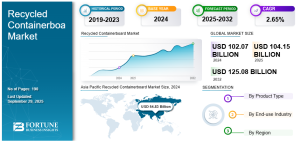
According to Fortune Business Insights, The global recycled containerboard market was valued at USD 102.07 billion in 2024 and is expected to expand from USD 104.15 billion in 2025 to USD 125.08 billion by 2032, reflecting a CAGR of 2.65% during the forecast period. Asia Pacific emerged as the leading region in 2024, accounting for 53.71% of the total market share.
With growing environmental awareness, stringent government regulations, and a global shift toward sustainable packaging, the recycled containerboard market is becoming a vital part of the packaging industry. Recycled containerboard, made from recovered fibers, offers both ecological and commercial benefits. It helps reduce landfill waste, limits deforestation, and supports circular economy initiatives. Industries such as e-commerce, food & beverages, healthcare, and personal care are increasingly adopting recycled containerboard for their packaging needs.

Containerboard refers to paperboard used primarily in the production of corrugated boxes and packaging materials. Recycled containerboard is manufactured using fibers recovered from post-consumer or post-industrial sources such as old corrugated containers (OCC), mixed paper, or recycled wood pulp. It is available in several product types, including linerboard and corrugating medium. The performance of recycled containerboard—such as strength, durability, and print quality—depends on the quality of the recycled feedstock and processing methods.
Other industry analyses estimate steady growth in demand, driven by increasing use of eco-friendly packaging and advancements in recycling technology. The broader containerboard market, which includes virgin fiber variants, is also expected to expand moderately in line with global packaging demand.
Leading companies in the global recycled containerboard market include: